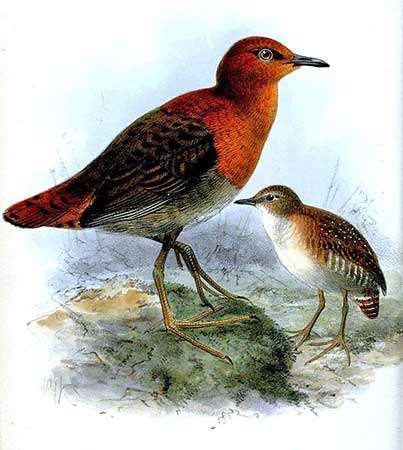
RANGE:
The Slender-billed Flufftail is restricted to the wetlands of E region, between Tsaratanana and Andringitra massifs at 900/1,800 metres of elevation.
HABITAT:
The Slender-billed Flufftail frequents small, elevated wetlands with Cyperus sedges, and can be seen in adjacent dense grassy areas and even in ricefields, usually near the rainforest, between 900 and 1,800 metres.
From some observations, the habitat tolerances of this species may be wider than supposed. As the rainforest has been removed from the site, the bird may also frequent overgrown, weedy, abandoned cultivated areas and the scrubby edges of marshes.
CALLS AND SONGS: SOUNDS BY XENO-CANTO
The Slender-billed Flufftail’s territorial call includes medium to low-pitched knocking and croaking sounds, rapidly repeated when given singly, or given ad doublets or triplets.
The single-note series is described as “tok-tok-tok-tok…” starting slowly and then accelerating and becoming more rhythmic, something like a galloping horse.
The doublets are “gu-duk gu-duk gu-duk…” or “GOO-goo…” and the triplets “tototok-tototok…” or “ug-ugug ug-ugug…”
The bird may sometimes use combinations of these calls. These fairly deep calls carry well in the dense marshland habitat. The alarm call is a short “tiec” note.
BEHAVIOUR IN THE WILD:
The feeding behaviour of the Slender-billed Flufftail is unknown, but we can suggest that it feeds on aquatic invertebrates and some amount of plant matter. It probably forages on the ground while probing leaf litter.
The Slender-billed Flufftail is apparently territorial during the breeding season, and gives complex territorial songs.
Information on social and sexual behaviour is not currently available.
The Slender-billed Flufftail is resident on the island.
The bird has been recorded flying over short distances, and it is more inclined to flush than other species. However, it is able to swim to escape a danger, and even to submerge entirely under extreme danger.
REPRODUCTION OF THIS SPECIES:
The breeding season may occur during rains. Males and females in breeding conditions were found in September in Andapa, and in October and November in Ranomafana. The males were calling to advertise the territory.
Adult and juvenile were reported in May at Laniera marshes, near Antananarivo. But this behaviour needs more studies.
PROTECTION / THREATS / STATUS:
The Slender-billed Flufftail is threatened by habitat loss through changes in wetland habitats for rice cultivation, the main diet of the increasing human population.
The wetlands are rarely included in protected areas in view of the need to expand rice cultivation. One site where the species occurs, Torotorofotsy Marsh, has benefited the conservation, but Lake Alaotra could be protected too if the species is found there.
The population is roughly estimated to number 350/1,500 individuals, and is suspected to be declining.
The Slender-billed Flufftail is globally threatened and currently classified Endangered.
Fr: Râle de Waters
Ang: Slender-billed Flufftail
All: Lemurenralle
Esp: Polluela de Waters
Ita: Codapiuma beccosottile
Nd: Bartletts Ral
Sd: smalnäbbad dunrall
Mal: dronga, Manganahitra, railovy
Illustrator:
John Gerrard Keulemans (1842-1912)
Illustration’s origin:
Proceedings of the Zoological Society of London 1879
Text by Nicole Bouglouan
Sources:
HANDBOOK OF THE BIRDS OF THE WORLD Vol 3 by Josep del Hoyo-Andrew Elliott-Jordi Sargatal - Lynx Edicions - ISBN : 8487334202
RAILS - Barry Taylor and Ber Van Perlo - Pica Press - IBSN 1873403593
Birds of Madagascar and the Indian Ocean Islands Par Roger Safford, Adrian Skerrett, Frank Hawkins – ISBN: 1472924118, 9781472924117- Editeur: Bloomsbury Publishing, 2015
Birds of the Indian Ocean Islands Par Ian Sinclair, Olivier Langrand - ISBN: 1868729567, 9781868729562- Editeur: Struik, 2003
The Birds of Africa: Volume VIII: The Malagasy Region: Madagascar, Seychelles, Comoros, Mascarenes - Par Roger Safford, Frank Hawkins – ISBN: 1408190494, 9781408190494- Editeur: A&C Black, 2013
Rails: A Guide to Rails, Crakes, Gallinules and Coots of the World – By Barry taylor – Illustration by Ber van Perlo – ISBN: 1408135388, 9781408135389 – Editeur: Bloomsbury Publishing, 2010
Slender-billed Flufftail
Sarothrura watersi
Gruiformes Order – Sarothruridae Family
INTRODUCTION:
The Slender-billed Flufftail is endemic to Madagascar. It occurs in a very restricted and patchy range in the montane wetlands of the east of the island. Very secretive and difficult to find, this species remains in dense vegetation with only occasional short flights.
The Slender-billed Flufftail has small population threatened by modification of wetlands for rice cultivation, and by rapid increase of human population. The species is currently classified Endangered.
DESCRIPTION OF THE BIRD:
Biometrics:
Length: 14-17 cm
Weight of one male: 26-27 g
The Slender-billed Flufftail has distinctive, almost plain plumage with dull chestnut head, neck, breast and mantle, with paler, mostly whitish chin and throat. Rest of upperparts including back, rump and upperwings is dark brown with indistinct darker streaks. The uppertail is chestnut with black-tipped feathers.
Rest of underparts including belly, flanks and undertail-coverts is uniformly ashy brown. The underwing is greyish-brown.
The bill is black. The eyes are brown. Legs and feet are pinkish-brown to pinkish-grey.
The adult female has chocolate-brown upperparts. The tail is black with narrow white bars and broader chestnut bars.
On the underparts, chin, throat and centre of breast are whitish. Rest of underparts is uniformly dark brown.
On the brown head, we can see a pale supercilium whereas the face is pale brown.
The immature is probably duller than adults. A captured immature male had olive-brown mantle with blackish-brown streaks. Head and neck were darker reddish-chestnut, whereas throat, breast and flanks were paler brown.
The juvenile female shows pale spots on back, and barred breast sides and flanks.
